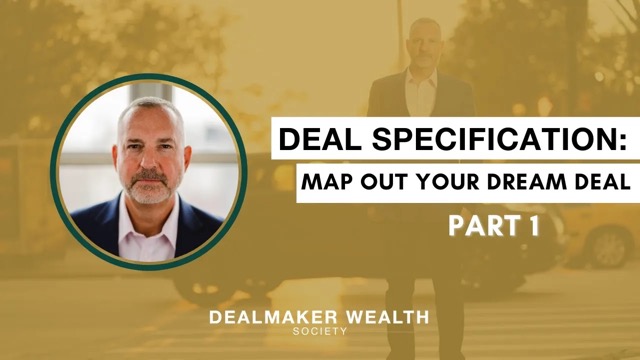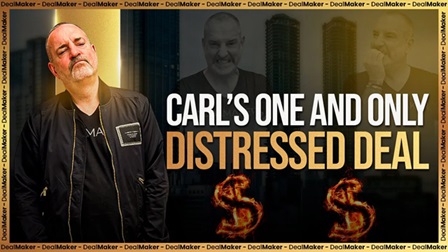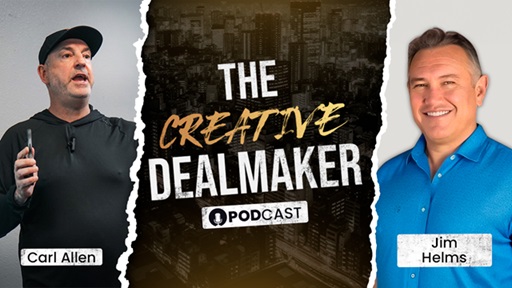Deal Specification: How to Fix Things in Your Business That Don’t Match Your Dream Deal
Deal Specification: How to Fix Things in Your Business That Don’t Match Your Dream Deal
Welcome to the next step in your business buying journey! In this video, Carl Allen walks you through the Deal Specification process—an essential step for anyone serious about acquiring the right business, without cash up front. You’ll learn how to define your ideal deal based on industry, location, lifestyle goals, your own skillset, and how to fix misalignments in a business that’s almost the perfect fit. From hiring the right team to rebranding or improving systems, Carl shows you how to shape a business around you.
You’ll also see a real-world example of how a buyer used Carl’s DDS tracker to build a 3-niche acquisition strategy using his existing expertise and network—without needing to reinvent himself. Plus, you’ll learn how to plan your ownership timeframe, explore bolt-on acquisitions, and prepare for long-term value creation. Be sure to download the free tracker template and tune in to the special training Carl mentions at the end—it’s a game changer. Let’s go build your dream deal!
Full Transcript:
Welcome to this YouTube channel on how to buy businesses no cash down. I’m Karl Allen, and I’ve been buying businesses for almost twenty five years, more than two hundred and fifty deals in seventeen countries.
This playlist is all about deal specification.
So what type of business do you want to buy? The sector, location, the size of the deal, your desired role in the business, and how you bring your passion, your business skills, and experiences to bear. Here’s the next video in the sequence. There are five in total.
To wrap this part up, let’s look at how to fix things in your new business that don’t quite map to your dream deal specification. Now this is gonna give you the flexibility to look at businesses that are a good fit, but not a perfect fit. Now we’re gonna go into this in a lot more detail in week ten. But for now, I want to briefly cover it. Most things can be fixed in any business. It just takes time and capital, both of which you’re going to have. And now we talked previously about hiring new employees to either strengthen your team or plug any skill gaps or do work that you don’t want to do.
You can also fix poor marketing, move to better premises, buy new equipment to either improve efficiency or provide capacity for further growth.
You may find a business that doesn’t have enough inventory, and you can use your funding to ramp that up. Same goes for better systems, better processes. These are important if you don’t plan on being in the business every day. And you can also rebrand your new business to give it a new look and a new feel to match you as the new owner. You may not want to change the name or the brand of your business, although some do. You need to balance the reputation that exists of the business before with the need perhaps for a fresh new look in the market.
And one final point is time frame. Although we cover this in more depth in the wealth creation plan video next up, it’s worth you figuring out now how long you want to own your business for. Are you looking to get in then out for a quick profit, say three months? Or do you want to own the business for longer? Twelve months, three years, ten years, sometimes even longer. And try to figure out as early as you can if you want to only have one business or bolt others into it.
Now once you’ve figured out all these questions for yourself, it’s time to put them into the tracker. In the what to do next video, right at the end of of week one set of videos, I’ll cover this in a bit more detail. But for now, let’s just quickly go through it.
The template for this is included in the resource section of week one. So download it and just put down how you feel about each of the questions we’ve debated so far. It will really help you focus your mind to commit to to a document, and then you can always tweak it moving forward if your circumstances change. So sheet one of the track is very basic, but lays down some of the important deal breakers, location, role, work life balance, etcetera.
In sheet two, you should list down your skills, your weaknesses, your primary sectors of expertise, your interest, and those primary expertise passion combinations that we talked about before. And then in sheet three, go into how you can leverage your existing network, your existing experiences to help you once you have your business.
Now this is an example of a tracker. The client clearly wanted to work in the business full time as the general manager and have no other interest. For that reason, the business needed to be close to home, although the client would have relocated for the right business, but the same country, actually didn’t want to immigrate and move his family.
Now this person was an operations and supply chain professional and had some general management experience. He was pretty weak on sales, finance, and marketing. So those were the areas that he needed to make sure that the business had some strength or they would be key new hires upon ownership, which in fact, I think is what he did. We also looked at this person’s expertise passion combination earlier. The passion was cars. And to be in the automotive sector, manufacturing parts was a strong expertise passion combination. Same for nautical components as number two and agriculture as number three.
So this tracker actually created three niche markets to target, automotive components within manufacturing, nautical components, and also agricultural components.
And the third part of this example is that this person also had a good network of suppliers, partners, and potential JVs, but had little by way of customer contacts as he wasn’t involved in sales in his previous career. Now this person wanted to own the business for three years before exit and was keen on growing it both organically and via bolt on acquisitions for some of the other niches. So buy the first business in the automotive sector and then maybe bolt on a nautical and an agricultural manufacturing business later on. The goal was to actually own a business that was doing all of these three subsectors, but but have three very specific divisions with dedicated sales teams within a combined operation.
The individual had also created a unique service model for the refurbishments of equipment in his existing business and also wanted to roll this out in all of these three new sectors to both increase the value and the service to the customer and make both more sales and profit. So those went down as other factors in the specification.
So that’s an example of how the DDS tracker works and what you need to do. Next, I want you to watch the existing business owner module as it will give you a really good insight into the bolt on acquisition process for your next deal if indeed you want to bolt other businesses on after you’ve done the first transaction.
So this tracker actually created three niche markets to target, automotive components within manufacturing, nautical components, and also agricultural components.
And the third part of this example is that this person also had a good network of suppliers, partners, and potential JVs, but had little by way of customer contacts as he wasn’t involved in sales in his previous career. Now this person wanted to own the business for three years before exit and was keen on growing it both organically and via bolt on acquisitions for some of the other niches. So buy the first business in the automotive sector and then maybe bolt on a nautical and a an agricultural manufacturing business later on. The goal was to actually own a business that was doing all of these three subsectors, but have three very specific divisions with dedicated sales teams within a combined operation.
The individual had also created a unique service model for the refurbishments of equipment in his existing business and also wanted to roll this out in all of these three new sectors to both increase the value and the service to the customer and make both small sales and profit. So those went down as other factors in the specification.
So that’s an example of how the DDS tracker works and what you need to do. Next, I want you to watch the existing business owner module as it will give you a really good insight into the bolt on acquisition process for your next deal if indeed you want to bolt other businesses on after you’ve done the first transaction.
So that’s it for this particular video. The next video in this playlist will follow, and please check out all the other playlists and videos for everything you need to know to learn how to buy a business no cash now. In fact, I’ve crammed everything that you need to know into a special ninety minute webinar titled three insider secrets to buy a profitable business inside of ninety nine days without cash or knowing how to run a business. And here are the three big secrets, the three killer training topics. Think of these as hurdles to you becoming a business owner. First, I’ll show you exactly what the ten steps are to buy a business, and you must follow these in order. It’s really critical.
Second, I’ll show you lots of case studies of deals structured using OPM, other people’s money, and it’s no more difficult than high school math. And finally, I’ll show you how you can get others to operate their businesses for you so you can do other things like spend time with your family or buy other businesses whilst enjoying the cash flow that your new business is generating for you. So to register for this groundbreaking training, just click on the link underneath this video on YouTube or type in this link into your browser. It’s b I t dot l y forward slash buy hyphen my hyphen business. And I’ll see you on air sometime in the next week. Until then, bye for now.




